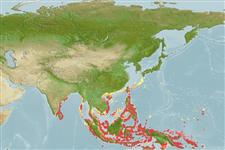Common names from other countries
>
Acanthuriformes (Surgeonfishes) >
Pomacanthidae (Angelfishes)
Etymology: Chaetodontoplus: Greek, chaite = hair + Greek, odous = teeth + Greek, plous, ous, oo = crossing (Ref. 45335).
More on author: Bloch.
Environment: milieu / climate zone / depth range / distribution range
Ecologia
marino associati a barriera corallina; non migratori; distribuzione batimetrica 1 - 20 m (Ref. 9710). Tropical; 36°N - 12°S, 78°E - 167°E
Indo-West Pacific: Japan to Indonesia, Sri Lanka and east to Papua New Guinea (Ref. 4859). Reported from Mentawai Islands (Ref. 27157). May consist of two separate species, one with an all-yellow tail and the other mostly gray tail (Ref. 48391).
Size / Peso / Age
Maturity: Lm ? range ? - ? cm
Max length : 18.0 cm TL maschio/sesso non determinato; (Ref. 9710)
Spine dorsali (totale) : 12; Raggi dorsali molli (totale) : 17 - 18; Spine anali: 3; Raggi anali molli: 17 - 18.
Inhabits continental shelf reefs; not usually found around oceanic islands (Ref. 9710). Feeds on sponges, tunicates, and filamentous algae (Ref. 9710). Forms small groups. Frequently exported through the aquarium trade (Ref. 48391). Very close to Chaetodontoplus poliourus Randall & Rocha, 2009 with different colors on pelvic, dorsal and caudal fins. The two species coexist in several islands of Indonesia (Ref. 82330) including Lesser Sunda Islands, Molucca Islands, Halmahera, and Bird's Head Peninsula of West Papua (Ref. 90102).
Life cycle and mating behavior
Maturities | Riproduzione | Spawnings | Egg(s) | Fecundities | Larve
Protogyny has been proposed for this species awaiting confirmation (Ref. 103751).
Myers, R.F., 1991. Micronesian reef fishes. Second Ed. Coral Graphics, Barrigada, Guam. 298 p. (Ref. 1602)
IUCN Red List Status (Ref. 130435)
CITES (Ref. 128078)
Not Evaluated
Threat to humans
Harmless
Human uses
Pesca: scarso interesse commerciale; Acquario: Commerciale
Strumenti
Special reports
Download XML
Fonti Internet
Estimates based on models
Preferred temperature (Ref.
115969): 25.5 - 29, mean 28.7 (based on 1472 cells).
Phylogenetic diversity index (Ref.
82804): PD
50 = 0.5000 [Uniqueness, from 0.5 = low to 2.0 = high].
Bayesian length-weight: a=0.03090 (0.01359 - 0.07026), b=2.89 (2.70 - 3.08), in cm Total Length, based on LWR estimates for this (Sub)family-body shape (Ref.
93245).
Trophic level (Ref.
69278): 2.7 ±0.00 se; based on food items.
Resilienza (Ref.
120179): Medio, tempo minimo di raddoppiamento della popolazione 1.4 - 4.4 anni (Preliminary K or Fecundity.).
Fishing Vulnerability (Ref.
59153): Low vulnerability (10 of 100).
